Nexus S and Android 2.3 Review: Gingerbread for the Holidays
by Brian Klug on December 14, 2010 4:08 PM EST- Posted in
- Smartphones
- Samsung
- Nexus S
- Gingerbread
- Android 2.3
- Mobile
Near Field Communication
Note that in the previous section I didn’t pop the back off the Nexus S and show you what’s underneath. That’s because what lies beneath is relevant to something new which the Nexus S has that no other Android smartphone has quite yet - Near Field Communication (NFC). NFC in practice is similar to RFID in that it’s a contactless, short range communications protocol - the two also work using magnetic induction and a loop antenna in the 13.56 MHz ISM band. If we finally remove the back of the Nexus S, you’ll see that loop antenna almost immediately.
There are two gold pins on the back of the Nexus S, and a corresponding set of pins on a flex circuit attached to the battery cover inside. If you look closely at an angle, there’s a very clear circular raised area which is that loop antenna, just like we’re used to seeing.
The principle is simple - bring the Nexus S near a smart tag, the smartphone induces some current, and the tag sends back some data. If the phone is on and you swipe it over a smart tag, the device will read it - you don’t need to launch an application or download something like barcode scanner. In its current state, the Nexus S can read these smart tags and act on them, offering functionality similar to a QR code. Currently scanning a tag launches the Google tag reader which shows you what information was in the tag, but other applications will be able to process tags with different intents just like you can open photos and documents with certain extensions using any Android application.

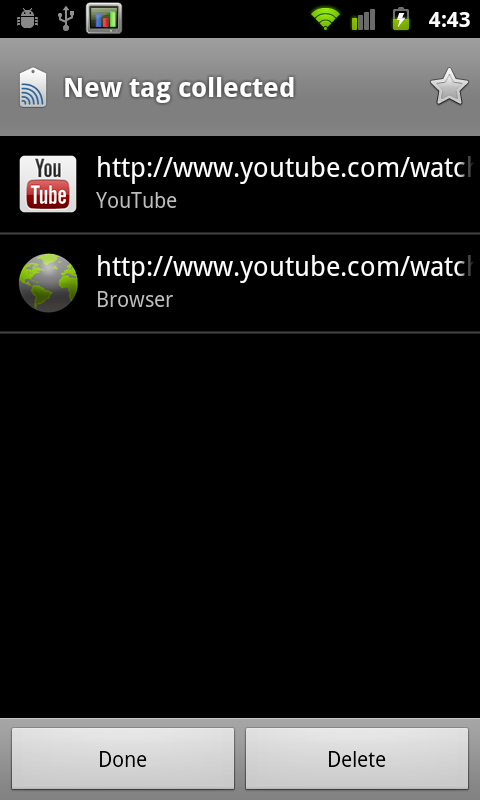
NFC right now works a lot like how QR codes do, but with a few differences. I experimented a long time ago with putting a QR code on my business card, with data in a simple vcard format. If you’ve ever tried this, you’ll quickly discover that the data you can fit on a QR code is rather limited - just under 3 kilobytes. You also have to launch an application, have some ambient illumination, and have a decent camera. QR codes are awesome, don’t get me wrong, but what NFC offers is the ability to do all of that faster, with more data (storage space is a function of the smart tag’s physical size), without launching anything. The tags themselves run around 5 to 25 cents.
But what about communicating with other devices and writing tags? That’s where NFC has the potential to be very interesting. There are three different operating modes for NFC - read/write which allows the device to read a passive smart tag, P2P mode which allows for bidirectional communication between two devices at up to 848 kilobits/s, and finally smart tag emulation, where the device acts like a passive contactless tag. The Nexus S NFC controller is NXP’s latest, the PN544, which has hardware support for all three modes. At present, Android 2.3 only supports read mode, but support for all three are coming.
Google has open sourced NXP’s controller software, and will slowly be updating the SDK with support for P2P mode and card emulation mode. At that point you can imagine applications like Bump leveraging NFC to transmit contact data between phones, using your smartphone as a mass-transit pass (buy your ticket on the phone, then use emulation mode to emulate the pass), or even a payment token.
Google sent along a sample Google Places smart tag with the Nexus S. This is the kind of tag they’ve shipped out in business kits to a number of locations in their pilot city of Portland, Oregon to help launch Google hotpot. This specific tag is big and constructed out of vinyl, but that’s purely because it’s intended to be placed in a storefront window. Other smart tags can be much smaller, like a stickers. Playing around with the tag, I couldn’t find a stiff region or trademark inflexible portion like I’m used to seeing with RFID tags.
Wave the phone over the sticker less than about five centimeters away, and it’ll read the tag. I tried through average thickness plate glass, and it worked fine. It’s insensitive to rotation, but works best when the phone is perpendicular and you couple those two loop antennas together - unsurprisingly. Reading the sample tag is nearly instant, and happens whenever the phone is on - a dialog pops up with info from the tag you’ve read. Inside tag reader is a long list of scanned tags.
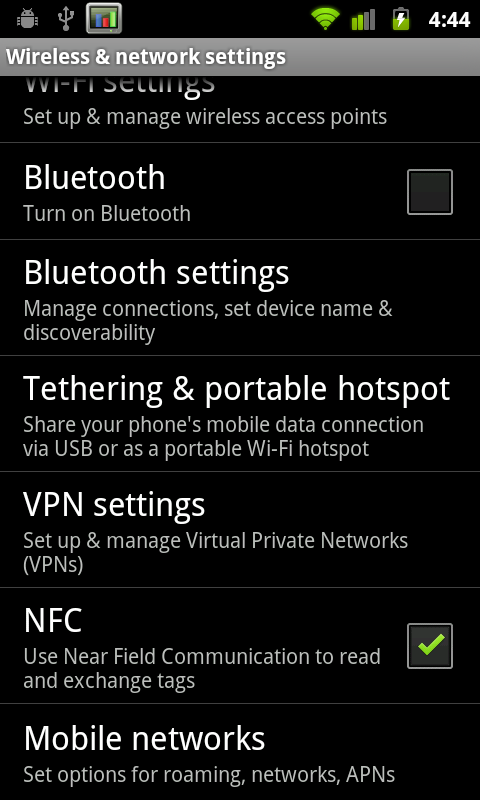
There’s a new settings option inside wireless & network settings for turning NFC on and off. Because NFC is always scanning in the background, it does use some current, but NXP’s documentation puts it at 50 microamps in power down mode with the RF detector active (ready to detect a tag), and 35 milliamps when briefly interacting with a tag. In practice, NFC shouldn’t adversely affect battery life. I haven’t had time yet, but will run our battery life tests with NFC turned on and off, but don’t expect a measurable difference. I’ve included a video of NFC reading the supplied tag in the Android 2.3 overview video on the following pages.
Though there aren’t very many NFC tags out in the wild waiting to be read yet, the same could be said for QR codes just one or two years ago. Hopefully NFC tags start cropping up, along with NFC enabled applications which use the P2P communications mode to transfer data. Of course, other device makers will have to build NFC readers into their devices as well


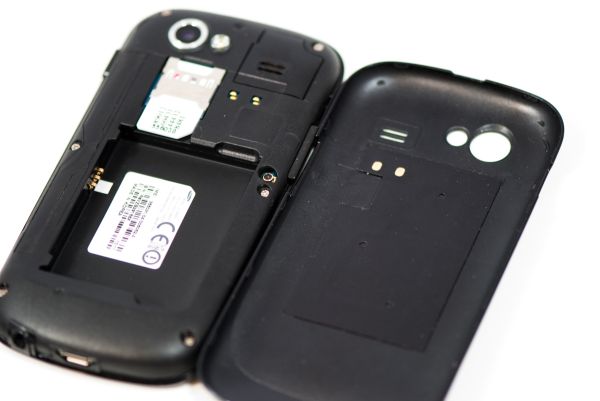
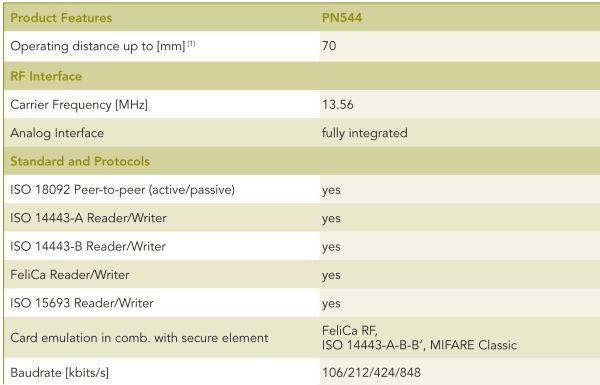
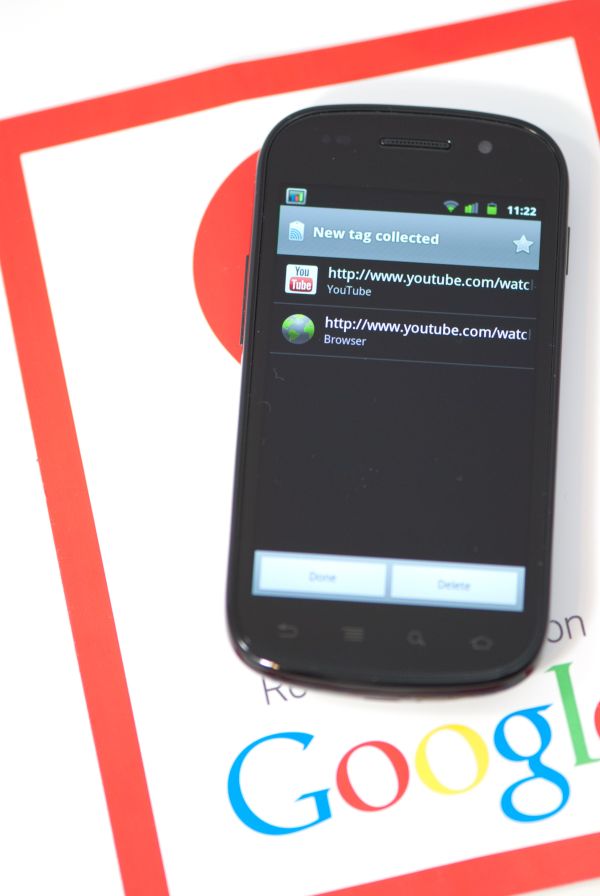








73 Comments
View All Comments
metafor - Wednesday, December 15, 2010 - link
AMOLED's emit light from each subpixel (diode). When it's displaying black, it simply doesn't emit any light. This results in true black; which is why you see their black level at 0.This comes with some limitations, of course, compared to LCD displays. One particular drawback is lack of great bright levels as well as readability in sunlight.
They also take more power when all the individual subpixels are lit up.
Chloiber - Wednesday, December 15, 2010 - link
Alltough I really don't like most of the smartphones from Samsung (just too much cheap plastic), I really liked the review (and the video).I'm really looking forward to Gingerbread - finally smooth Animations. You can already have those, but only with a good custom ROM. Gingerbread + custom ROM will rock the house! :-)
Guspaz - Wednesday, December 15, 2010 - link
I really hope that the phone number (1-408-505-xxxx) on page 6 is not a real phone number...tpurves - Wednesday, December 15, 2010 - link
Interesting to see how little difference the 21MBits/s hspa+ made in your tests.On Canadian HSPA+ 21 networks I've seen speed tests as much as 13 Megabits/sec down and 1.2-1.6 up. That's fast! and nearly twice your measured speeds. Bear in mind those speeds where achieved with a USB 3G adapter not a handset.
http://wirelessnorth.ca/2010/05/24/rogers-21-6mbs-...
spaceboy33 - Wednesday, December 15, 2010 - link
Any idea when the mytouch 4g review will be posted? Currently trying to decide between these two phones and another review as detailed as this one would be a big help.Ullteppet - Wednesday, December 15, 2010 - link
First off, you guys deliver the hands down most thorough articles and reviews the internet has ever seen - and we're ever grateful for your unbiased, hard effort, keep it up!I didn't fully get the video recording though. First page table says it has 720p, but the camera pages states it lacks 720p. Is the table wrong or does it only reflect the potential of the camera, since the limitation seems to be in gingerbread?
Brian Klug - Thursday, December 16, 2010 - link
Oops, you're indeed correct. The Nexus S lacks 720P video recording, at least out of the box with stock 2.3. I'm sure it'll be added in by the XDA-Devs within a few days at max.-Brian
sicofante - Wednesday, December 15, 2010 - link
I know you're an American site and that Americans don't care that much about the biggest phone maker in the world (Nokia). However, since this is published in the worldwide web I believe your comparisons would be more useful to your worldwide audience if you included the newest phones from Nokia, such as the N8 or C7.ojisama - Tuesday, December 21, 2010 - link
I've also been refreshing the main page to see a review of N8 before Christmas, but apparently getting the review out in the time span between the release of the phone in October and Christmas was impossible. (Well, technically the article could still come out before xmas, but now it's too late to get the phone...)Well, apparently there will be an update for the phone soon, so hopefully this will be installed and tested before the article is released...
rcocchiararo - Wednesday, December 15, 2010 - link
Swype has arrow keysSwyping forom "swype button" to "sym button" takes you to that keyboard.